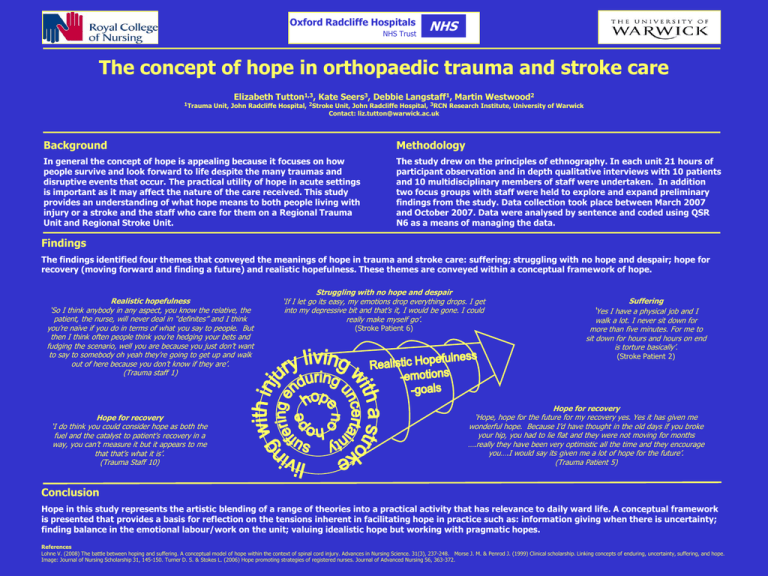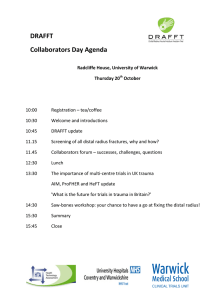The concept of hope in orthopaedic trauma and stroke care NHS
advertisement

Oxford Radcliffe Hospitals NHS Trust NHS The concept of hope in orthopaedic trauma and stroke care 1Trauma Elizabeth Tutton1,3, Kate Seers3, Debbie Langstaff1, Martin Westwood2 Unit, John Radcliffe Hospital, 2Stroke Unit, John Radcliffe Hospital, 3RCN Research Institute, University of Warwick Contact: liz.tutton@warwick.ac.uk Background Methodology In general the concept of hope is appealing because it focuses on how people survive and look forward to life despite the many traumas and disruptive events that occur. The practical utility of hope in acute settings is important as it may affect the nature of the care received. This study provides an understanding of what hope means to both people living with injury or a stroke and the staff who care for them on a Regional Trauma Unit and Regional Stroke Unit. The study drew on the principles of ethnography. In each unit 21 hours of participant observation and in depth qualitative interviews with 10 patients and 10 multidisciplinary members of staff were undertaken. In addition two focus groups with staff were held to explore and expand preliminary findings from the study. Data collection took place between March 2007 and October 2007. Data were analysed by sentence and coded using QSR N6 as a means of managing the data. Findings The findings identified four themes that conveyed the meanings of hope in trauma and stroke care: suffering; struggling with no hope and despair; hope for recovery (moving forward and finding a future) and realistic hopefulness. These themes are conveyed within a conceptual framework of hope. Realistic hopefulness „So I think anybody in any aspect, you know the relative, the patient, the nurse, will never deal in “definites” and I think you‟re naïve if you do in terms of what you say to people. But then I think often people think you‟re hedging your bets and fudging the scenario, well you are because you just don‟t want to say to somebody oh yeah they‟re going to get up and walk out of here because you don‟t know if they are‟. (Trauma staff 1) Hope for recovery „I do think you could consider hope as both the fuel and the catalyst to patient‟s recovery in a way, you can‟t measure it but it appears to me that that‟s what it is‟. (Trauma Staff 10) Struggling with no hope and despair „If I let go its easy, my emotions drop everything drops. I get into my depressive bit and that‟s it, I would be gone. I could really make myself go‟. (Stroke Patient 6) Suffering „Yes I have a physical job and I walk a lot. I never sit down for more than five minutes. For me to sit down for hours and hours on end is torture basically‟. (Stroke Patient 2) Hope for recovery „Hope, hope for the future for my recovery yes. Yes it has given me wonderful hope. Because I‟d have thought in the old days if you broke your hip, you had to lie flat and they were not moving for months ….really they have been very optimistic all the time and they encourage you….I would say its given me a lot of hope for the future‟. (Trauma Patient 5) Conclusion Hope in this study represents the artistic blending of a range of theories into a practical activity that has relevance to daily ward life. A conceptual framework is presented that provides a basis for reflection on the tensions inherent in facilitating hope in practice such as: information giving when there is uncertainty; finding balance in the emotional labour/work on the unit; valuing idealistic hope but working with pragmatic hopes. References Lohne V. (2008) The battle between hoping and suffering. A conceptual model of hope within the context of spinal cord injury. Advances in Nursing Science. 31(3), 237-248. Morse J. M. & Penrod J. (1999) Clinical scholarship. Linking concepts of enduring, uncertainty, suffering, and hope. Image: Journal of Nursing Scholarship 31, 145-150. Turner D. S. & Stokes L. (2006) Hope promoting strategies of registered nurses. Journal of Advanced Nursing 56, 363-372.





